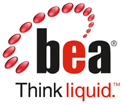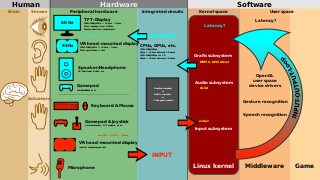
BEA Systems, Inc. was a company specialized in enterprise infrastructure software products which was wholly acquired by Oracle Corporation on April 29, 2008.
Enterprise application integration (EAI) is the use of software and computer systems' architectural principles to integrate a set of enterprise computer applications.

An enterprise service bus (ESB) implements a communication system between mutually interacting software applications in a service-oriented architecture (SOA). It represents a software architecture for distributed computing, and is a special variant of the more general client-server model, wherein any application may behave as server or client. ESB promotes agility and flexibility with regard to high-level protocol communication between applications. Its primary use is in enterprise application integration (EAI) of heterogeneous and complex service landscapes.
Enterprise architecture (EA) is "a well-defined practice for conducting enterprise analysis, design, planning, and implementation, using a comprehensive approach at all times, for the successful development and execution of strategy. Enterprise architecture applies architecture principles and practices to guide organizations through the business, information, process, and technology changes necessary to execute their strategies. These practices utilize the various aspects of an enterprise to identify, motivate, and achieve these changes."
Enterprise software, also known as enterprise application software (EAS), is computer software used to satisfy the needs of an organization rather than individual users. Such organizations include businesses, schools, interest-based user groups, clubs, charities, and governments. Enterprise software is an integral part of a (computer-based) information system; a collection of such software is called an Enterprise system.
In information technology, data architecture is composed of models, policies, rules or standards that govern which data is collected, and how it is stored, arranged, integrated, and put to use in data systems and in organizations. Data is usually one of several architecture domains that form the pillars of an enterprise architecture or solution architecture.
Oracle Fusion Middleware consists of several software products from Oracle Corporation. FMW spans multiple services, including Java EE and developer tools, integration services, business intelligence, collaboration, and content management. FMW depends on open standards such as BPEL, SOAP, XML and JMS.
An integration competency center (ICC), sometimes referred to as an integration center of excellence (COE), is a shared service function providing methodical data integration, system integration, or enterprise application integration within organizations, particularly large corporations and public sector institutions.
The Governance Interoperability Framework (GIF) is an open, standards-based specification and set of technologies that describes and promotes interoperability among components of a service-oriented architecture (SOA). GIF integrates SOA ecosystem technologies to achieve heterogeneous service lifecycle governance and is supported by Hewlett-Packard Company and by GIF partners.
A talent management system (TMS) is an integrated software suite that addresses the "four pillars" of talent management: recruitment; performance management; learning and development; and compensation management.
Enterprise interoperability is the ability of an enterprise—a company or other large organization—to functionally link activities, such as product design, supply chains, manufacturing, in an efficient and competitive way.
Web data services refers to service-oriented architecture (SOA) applied to data sourced from the World Wide Web and the Internet as a whole. Web data services enable maximal mashup, reuse, and sharing of structured data, semi-structured information, and unstructured information.
The JBoss Enterprise SOA Platform is free software/open-source Java EE-based service-oriented architecture (SOA) software. The JBoss Enterprise SOA Platform is part of the JBoss Enterprise Middleware portfolio of software. The JBoss Enterprise SOA Platform enables enterprises to integrate services, handle business events, and automate business processes, linking IT resources, data, services and applications. Because it is Java-based, the JBoss application server operates cross-platform: usable on any operating system that supports Java. The JBoss SOA Platform was developed by JBoss, now a division of Red Hat.
Model Driven Interoperability (MDI) is a methodological framework, which provides a conceptual and technical support to make interoperable enterprises using ontologies and semantic annotations, following model driven development (MDD) principles.
Unified interoperability is the property of a system that allows for the integration of real-time and non-real time communications, activities, data, and information services and the display and coordination of those services across systems and devices. Unified interoperability provides the capability to communicate and exchange processing across different applications, data, and infrastructure.
Business-oriented architecture is an enterprise architecture approach for designing and implementing strategically aligned business models.
Guy Doumeingts is a French engineer, Emeritus professor at the University of Bordeaux 1 and former Director of "Laboratoire d’Automatique, Productique Signal et Image" control theory, known for the development of the GRAI method and his contributions to the field of Enterprise modelling.
The INTEROP V-Lab is a network of organizations, which links scientists, research centers, representatives of industry, and small and medium-sized enterprises. The members come from several European countries as well as China and represent 250 scientists and 70 organizations.




